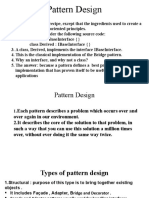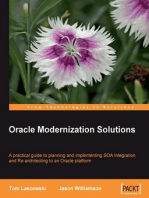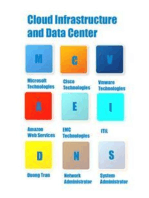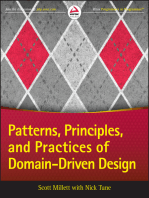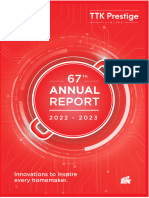0 ratings0% found this document useful (0 votes)
88 viewsJ2EE Patterns: Slides by Igor Polevoy
This document discusses various Java EE patterns including Session Facade, Message Facade, EJB Command, Data Transfer Object Factory, Generic Attribute Access, and Business Interface patterns. It provides definitions of patterns, their benefits, examples of how to implement them, and potential disadvantages. The patterns are presented as solutions to common problems in Java EE application design such as loose coupling between layers and transaction management.
Uploaded by
Sushil BharwaniCopyright
© Attribution Non-Commercial (BY-NC)
Available Formats
Download as PPT, PDF, TXT or read online on Scribd
0 ratings0% found this document useful (0 votes)
88 viewsJ2EE Patterns: Slides by Igor Polevoy
This document discusses various Java EE patterns including Session Facade, Message Facade, EJB Command, Data Transfer Object Factory, Generic Attribute Access, and Business Interface patterns. It provides definitions of patterns, their benefits, examples of how to implement them, and potential disadvantages. The patterns are presented as solutions to common problems in Java EE application design such as loose coupling between layers and transaction management.
Uploaded by
Sushil BharwaniCopyright
© Attribution Non-Commercial (BY-NC)
Available Formats
Download as PPT, PDF, TXT or read online on Scribd
You are on page 1/ 64
J2EE Patterns
Slides by Igor Polevoy
October 30 2003
Pattern Definition
• Pattern is a best practice solution to a
common recurring problem
• Pattern describes a recurring problem
• Pattern describes a typical solution to the
problem
• Patterns are collective knowledge
• Patterns are great vehicle to share
knowledge with more people
Pattern Benefits
• Provides a high level language for design
discussions
• Provides a well tested solution for a
common problem
• Helps provide some design work
• Combinations of patterns tend to provide
for reusable architecture frameworks
Pattern History
• Christopher Alexander: A Pattern
Language 1977
• Gamma, etc (Gang of Four, GoF): Design
Patterns: Elements of Reusable Object-
Oriented Software 1994
GoF Pattern Categories
• Creational
– Singleton
– Abstract Factory
• Structural
– Decorator
– Adapter
• Behavioral
– Strategy
– Chain of Responsibility
EJB Layer Patterns
• Session Façade
• Message Façade
• EJB Command
• Data Object Transfer Factory
• Generic Attribute Access
• Business Interface
Example of J2EE Application
Fine-Grained Access
Disadvantages
• Increased network overhead
• Client needs to have intimate knowledge of server side
components
• Data access, business and workflow logic scattered
across client
• Tight coupling of clients and server components
• Transaction not managed, funds can be in the undefined
state
• Poor people role separation
• Poor maintainability
• Poor reusability
Fine-Grained Access Solutions
– Encapsulate all logic inside entity beans, have
client make just one call
• Disadvantages: tight coupling of business logic and
data, lower level of component reuse
– Transaction demarcation handled by client
• If client is far away, transactions will run for long
time, reducing overall performance of system
• Client needlessly complex
• Solves only data integrity problem
Session Façade Pattern
• Façade Pattern (GoF) provides a unified
interface to a set of interfaces in a subsystem.
Façade provides a higher-level interface that
makes it the sub-system easier to use
• Session Façade Pattern applied to J2EE only
• Session Façade provides a layer of abstraction
to subsystem of session beans, entity beans and
other components
• Hides server component complexity from client
Session Façade Pattern
• Implemented as a layer of stateless beans
(sometimes statefull)
• Provides a clean interface to execute
business logic and workflow
• Separates complexity from client
• Provides for automatic transaction support
• Separates development roles
• From OO point of view provides for layer of
abstraction and encapsulation
Session Façade Pattern
• Before
Session Façade Pattern
• After:
Session Façade Pattern
• Solution:
Session Facade
• Benefits:
– Lower network overhead
– Separation of business logic from
presentation
– Inherent transaction support
– Promotes reusability
– Looser coupling
Session Facade Dangers
• Do not create a God Session Façade
• Do not put presentation logic into façade
• Do not use Session Façade as domain
model, use it only as glue
Situation in Enterprise
• Need to execute a number of session and
entity beans in a context of the same
transaction
• Immediate response is not required
• Client does not have to be required to wait
end of execution
Situation in Enterprise
Solutions
• Use Session Façade Pattern
– Solves the following problems:
• Coupling
• Performance
• Maintainability
• Data integrity
– Does not solve:
• Response time
• Reliability
Message Façade Pattern
Message Façade Pattern
• Use a Message Driven Bean to create a
reliable fault-tolerant façade
• Client should only send messages to JMS
destination. They should not access
session and entity beans directly
Message Façade Pattern
• Solves:
– Response time
• Inherently by use of messaging
– Reliability
• If a transaction fails, then the MDB can push the
message back into destination; the message will
be re-delivered
Message Façade Pattern
• Usage:
– Do not put business logic into MDB
– Use Message Façade pattern together with
Session Façade Pattern
• Disadvantages:
– Propagate results back to client
– Cannot perform compile time type checking
Command Design Pattern (GoF)
• Used to encapsulate executable logic in
command units
• Decouples application client component
from domain model
• Used to provide undo/redo functionality
EJB Command Pattern
• Goal: to decouple application client
component from binding to concrete
domain model objects
• Separate development roles in projects
• Simplify access to Session Façade
• Use command beans with set/get methods
and execute method
EJB Command Pattern
EJB Command Pattern
• Elements:
– Command Beans
– Client side routing logic
– Command server
EJB Command Pattern
• Benefits:
– Easier to deploy the application (fewer
session beans)
– Separates business logic from presentation
– Decouples application client component from
EJBs
– Command can execute locally, produce fake
data to facilitate independent development
EJB Command Pattern
• Disadvantages
– Primitive transaction control (limited by
command server)
– Commands are stateless – no easy way to
access statefull beans
– Limited exception handling mechanism
– Command beans classes loaded into J2EE
runtime – no easy way to change functionality
on the fly
Data Transfer Object Pattern
Data Transfer Object Pattern
DTO Factory Pattern
• Problem with DTO:
– DTOs change very often
– Entity beans need to be updated
– DTO consumption is unclear
– Business domain logic creeps into entity
beans
• Solution:
– Place responsibility for creation/consumption
of DTOs onto DTO Factories
DTO Factory Pattern
• DTO Factory Pattern can be implemented
as:
– Simple java class
– Session bean
DTO Factory Pattern
DTO Factory Pattern
• Benefits:
– Changes in creation of DTOs are performed in DTO Factories,
making entity beans more stable
– DTO Factory can create different views of the same data
– DTO Factory can create complex composite DTOs, which hold
data from multiple entity beans
– DTO Factory can provide consumption of DTOs:
• Application client will create a DTO, will set all necessary attributes,
it will then pass it to DTOFactory.setXXXDTO() – this will cause the
factory to find appropriate entity beans ad call their respective set
methods all in the context of one transaction
– Multiple applications can reuse the same persistence layer as
long as they provide DTO Factories with appropriate logic
DTO Factory Usage
DTO Factory Pattern Problems
• Does not scale well with attribute number
growth
• Entity bean clients are tightly coupled with
entity bean interfaces
• Solution: Generic Attribute Access Pattern
Generic Attribute Access Pattern
• Move attribute access logic from entity
bean client to a generic attribute access
class
• This class will provide access to attributes
via Maps of attribute keys and their
respective values
Generic Attribute Access Pattern
• Attribute access is built into entity beans as
implementation of AttributeAccess interface
• Such interface would be implemented by a
remote or local interface and the beans itself
interface AttributeAccess
{
void setAttributes(Map attributes);
Map getAttributes();//gets all attributes
Map getAttributes(Set keys);//gets some attributes
}
Generic Attribute Access Pattern
Generic Attribute Access Pattern
• Benefits:
– A BMP can hold it’s state in a Map, simplifying the
GAA implementation
– No need to program DTOs
– Attribute access code can be shared by all beans in
the system – simplicity
– In CMP, Java Reflection API can be used for updates
– same code can be shared between all CMPs in the
system (use a super class)
– Scales well for large number of attributes/beans
– One attribute access interface across all beans
– Allows for creation of generic clients
Generic Attribute Access Pattern
• Tradeoffs:
– Additional overhead: need to construct an
attribute access call, need to cast the attribute
value
– Need to maintain attribute contract
– No compile-time type checking
Generic Attribute Access Pattern
• Recommendations:
– Provide a well documented contract for attribute naming
conventions
– Use Java Beans design patterns for naming conventions
– Can se static finals on bean classes for run time name checking
– Can use a shared interface that serves as a name binding
contract:
Interface PersonBeanNames
{
public static final String firstName;
public static final String lastName;
public static final String ssn;
. . .
}
Business Interface Pattern
• Create a business interface for a bean
• Extend it in the remote/local interface
• Implement it in the bean class
Data Transfer RowSet Pattern
• Transfer relational data in a tabular format
to client application
• If use DTOs you convert tabular data to
OO (EJB), then back to tabular (HTML)
• Use JDBC + RowSet to transfer tabular
data directly to client
Data Transfer RowSet Pattern
• Advantages:
– Can use the same generic client code to process all
tabular requests
– Can use GUI automation (automatic rendering of
ResultSet)
• Tradeoffs:
– No compile time checking
– Not OO
– Client may need to know DB structure (can be
remedied by Session Facade Pattern)
Version Number Pattern
• Problem:
– Data read is performed in a different
transaction then data update
– Hence – danger of update on stale data
– Difficult to wrap read/write into the same
transaction because of “think time”
– Data collision can happen
Version Number Pattern
• Solution:
– Use record (bean) version number
– Include version number into the cross tier
transmission
– Send version number back for update along
with any changed attributes
– Before update, validate version number
– Reject update if stale record is updated
– When update happen, increment version
number
Version Number Pattern
• Implementation
– Depends on inter-tier transmission pattern
– Have legacy applications update data through
J2EE persistence layer; if impossible, write
DB triggers that update version numbers
JDBC For Reading
or
Fast Lane Reader Pattern
• Problems accessing entity beans for
reading:
– N+1 DB read problem
– Network overhead for multiple calls
– Join operations are difficult
JDBC For Reading Pattern
• Solution:
– Use straight JDBC for read operations
– Use CMPs for update operations
– Use in conjunction with other patterns
• Benefits:
– No transaction dependency
– DBMS cache mechanism used
– Simple to join data
• Tradeoffs:
– Bug prone
– No compile time type checking
– Tight coupling of client and persistence layers
Data Access Command Bean
Pattern
• Without DACB, session beans access
entity beans and JDBC directly
• Problems:
– Tight coupling between session layer and
persistence implementation
– Data access logic mixed in with business logic
– Session bean layer is dependent on schema
changes
– High potential for copy/paste style code reuse
Data Access Command Bean
Pattern
• Encapsulate persistence logic into Bean
Command classes
• Bean Command interfaces provide a layer of
abstraction from concrete implementation of
persistence layer
• Similar to EJB Command Pattern
• Differences from EJB Command Pattern:
– DACB provides transparent interface to EJBs, JDBC,
ObjectStore, etc (as opposed to session bean layer)
– Serves as insulation layer between Session Beans
(facade) and concrete persistence implementation
– Semantically models data closer
Data Access Command Bean
Pattern
Data Access Command Bean
Pattern
Data Access Command Bean
Pattern
Data Access Command Bean
Pattern
• Benefits:
– Provides a clean abstraction layer for data
store
– Usable in any tier
– Decouples business logic from storage logic
– Facilitates independent development if
dummy commands are used
• Disadvantages:
– Extra work for developers
EJBHomeFactory Pattern
(Service Locator Pattern)
• Problems:
– Client has repetitive code for lookups of home
interfaces
– Each time the lookup is done, a potential
network call is performed
EJBHomeFactory Pattern
• Solution:
– Provide a factory class, which encapsulates
all of the lookup code, and potentially caches
home interfaces
– Usually implemented as Singleton
Example:
Account acc =
BusinesInterfaceFactory.getInstance().getInterf
ace(com.acme.Account.class);
All of the factory parameters for JNDI lookups
are stored in the configuration of a factory.
EJBHomeFactory Pattern
• Can be used in conjunction with Abstract
Factory Pattern to make creation of
business interfaces completely transparent
to client code
Business Delegate Pattern
• Problem:
– When client uses a session façade or other interface
to J2EE logic, there is a tight coupling between
application client components and EJBs
– Programming directly to EJB layer in not the best way
• Clients need to be aware and handle transaction J2EE
exceptions
• Complicates client logic with EJB exception handling
• Couples client directly to EJB or JMS (message facade) APIs
Business Delegate Pattern
• Solution:
– Create a layer of abstraction that insulates
application client components from handling
service discovery, complex exception
handling and recovery
– A Business Delegate is a plain Java class that
usually maps to session façade one – to one
Business Delegate Responsibilities
• Delegate requests to session façade or
message façade
• Hide EJB API exceptions behind application
level exceptions
• May cache data locally
• May retry failed requests transparently to client
• Assists in large projects if dummy business
delegates are used to asynchronously develop
client and server functionality
Pattern Categories
• EJB Layer
– Session Façade
– Message Façade
– EJB Command
– Data Transfer Object Factory
– Generic Attribute Access
– Business Interface
• Inter-tier data transfer
– DTO
– Data Transfer HashMap
– Data Transfer RowSet
• Transaction/persistence
– Version Number
– JDBC for Reading
– Data Access Command Bean
– Dual Persistence Entity Bean (CMP/BMP)
• Client-side EJB Interaction
– EJB Home Factory
– Business Delegate
You might also like
- Applying Domain-Driven Design and Patterns - With Examples in C#100% (3)Applying Domain-Driven Design and Patterns - With Examples in C#613 pages
- J2EE Design Patterns: Sharath Sahadevan August 8, 2002 ST Louis Java SIGNo ratings yetJ2EE Design Patterns: Sharath Sahadevan August 8, 2002 ST Louis Java SIG35 pages
- EJB Strategies, Tips and Idioms: Don't Use The Composite/Aggregate/Coarse-Grained Entity Bean PatternNo ratings yetEJB Strategies, Tips and Idioms: Don't Use The Composite/Aggregate/Coarse-Grained Entity Bean Pattern3 pages
- 7) Development of Enterprise ApplicationNo ratings yet7) Development of Enterprise Application47 pages
- Java/J2EE Design Patterns Interview Questions You'll Most Likely Be Asked: Second EditionNo ratings yetJava/J2EE Design Patterns Interview Questions You'll Most Likely Be Asked: Second Edition22 pages
- Expert One On One J2EE Design and DeveloNo ratings yetExpert One On One J2EE Design and Develo16 pages
- Adv - Java Means Durga Sir: Plot No: 202, Iind Floor, Huda Maitrivanam, Ameerpet, Hyd-5000038No ratings yetAdv - Java Means Durga Sir: Plot No: 202, Iind Floor, Huda Maitrivanam, Ameerpet, Hyd-500003810 pages
- Software Design and Architecture - Chapter 01No ratings yetSoftware Design and Architecture - Chapter 0118 pages
- A Presentation Tier Component Is Requesting Data AttributesNo ratings yetA Presentation Tier Component Is Requesting Data Attributes24 pages
- Design Patterns - Assignment Sample 6 With AnswersNo ratings yetDesign Patterns - Assignment Sample 6 With Answers13 pages
- Java - Good Practices and Recommendations - Design Patterns PDFNo ratings yetJava - Good Practices and Recommendations - Design Patterns PDF1 page
- J2Ee Design Patterns: Intercepting FilterNo ratings yetJ2Ee Design Patterns: Intercepting Filter15 pages
- Presented By: Yingpeng (Rocky) Wu 2011 Winter SemesterNo ratings yetPresented By: Yingpeng (Rocky) Wu 2011 Winter Semester49 pages
- EJB Basics - by Example: Dave Landers BEA Systems, IncNo ratings yetEJB Basics - by Example: Dave Landers BEA Systems, Inc47 pages
- Design Patterns: The Power of Reusable SolutionsNo ratings yetDesign Patterns: The Power of Reusable Solutions30 pages
- Sample Questions Advance Java-Design PatternNo ratings yetSample Questions Advance Java-Design Pattern23 pages
- Java / J2EE Interview Questions You'll Most Likely Be AskedFrom EverandJava / J2EE Interview Questions You'll Most Likely Be AskedNo ratings yet
- Learning Design Patterns with Unity: Learn the secret of popular design patterns while building fun, efficient games in Unity 2023 and C#From EverandLearning Design Patterns with Unity: Learn the secret of popular design patterns while building fun, efficient games in Unity 2023 and C#No ratings yet
- Learn Professional Programming in .Net Using C#, Visual Basic, and Asp.NetFrom EverandLearn Professional Programming in .Net Using C#, Visual Basic, and Asp.NetNo ratings yet
- Applied Architecture Patterns on the Microsoft Platform Second EditionFrom EverandApplied Architecture Patterns on the Microsoft Platform Second EditionNo ratings yet
- Catchlogs - 2024-04-07 at 01-43-40 - 7.60.0 - .JavaNo ratings yetCatchlogs - 2024-04-07 at 01-43-40 - 7.60.0 - .Java52 pages
- Home Range Creation and Analysis Using Geospatial Modeling Environment and Arcgis SoftwareNo ratings yetHome Range Creation and Analysis Using Geospatial Modeling Environment and Arcgis Software15 pages
- Analysis and Prediction of Crime Against Woman Using Machine Learning TechniquesNo ratings yetAnalysis and Prediction of Crime Against Woman Using Machine Learning Techniques6 pages
- Sturmbot 1.9 Install For Day of Defeat Steam - Version 2No ratings yetSturmbot 1.9 Install For Day of Defeat Steam - Version 28 pages
- Communication Projects in Labview With PDFNo ratings yetCommunication Projects in Labview With PDF2 pages
- PDF Deep Learning For Remote Sensing Images With Open Source Software 1st Edition Rémi Cresson DownloadNo ratings yetPDF Deep Learning For Remote Sensing Images With Open Source Software 1st Edition Rémi Cresson Download53 pages
- Project Report On Emotion Aware Smart Music Recommended System Using CNNNo ratings yetProject Report On Emotion Aware Smart Music Recommended System Using CNN11 pages
- Automated Software Testing For MATLAB (2009)No ratings yetAutomated Software Testing For MATLAB (2009)8 pages
- Mobile Internet Protocol: by Nithiyapriya .PNo ratings yetMobile Internet Protocol: by Nithiyapriya .P11 pages
- Engineer I Have A Query and I Send You ImagesNo ratings yetEngineer I Have A Query and I Send You Images23 pages
- Instant Download JavaScript Unlocked 1st Edition Sheiko PDF All Chapters100% (7)Instant Download JavaScript Unlocked 1st Edition Sheiko PDF All Chapters77 pages
- Python-Basic-Elements-String-sets-DictionariesNo ratings yetPython-Basic-Elements-String-sets-Dictionaries132 pages
- SAP HANA Developer Guide For SAP HANA Studio en100% (1)SAP HANA Developer Guide For SAP HANA Studio en904 pages
- Hong Kong Arrow Trading Co., Limited: Proforma InvoiceNo ratings yetHong Kong Arrow Trading Co., Limited: Proforma Invoice1 page
- Walkthrough - Printing A Local Report Without PreviewNo ratings yetWalkthrough - Printing A Local Report Without Preview6 pages
- Answer key Class vii computer for Half Yearly examinationNo ratings yetAnswer key Class vii computer for Half Yearly examination5 pages
- Applying Domain-Driven Design and Patterns - With Examples in C#Applying Domain-Driven Design and Patterns - With Examples in C#
- SRS - How to build a Pen Test and Hacking PlatformFrom EverandSRS - How to build a Pen Test and Hacking Platform
- J2EE Design Patterns: Sharath Sahadevan August 8, 2002 ST Louis Java SIGJ2EE Design Patterns: Sharath Sahadevan August 8, 2002 ST Louis Java SIG
- EJB Strategies, Tips and Idioms: Don't Use The Composite/Aggregate/Coarse-Grained Entity Bean PatternEJB Strategies, Tips and Idioms: Don't Use The Composite/Aggregate/Coarse-Grained Entity Bean Pattern
- Java/J2EE Design Patterns Interview Questions You'll Most Likely Be Asked: Second EditionJava/J2EE Design Patterns Interview Questions You'll Most Likely Be Asked: Second Edition
- Adv - Java Means Durga Sir: Plot No: 202, Iind Floor, Huda Maitrivanam, Ameerpet, Hyd-5000038Adv - Java Means Durga Sir: Plot No: 202, Iind Floor, Huda Maitrivanam, Ameerpet, Hyd-5000038
- A Presentation Tier Component Is Requesting Data AttributesA Presentation Tier Component Is Requesting Data Attributes
- Design Patterns - Assignment Sample 6 With AnswersDesign Patterns - Assignment Sample 6 With Answers
- Java - Good Practices and Recommendations - Design Patterns PDFJava - Good Practices and Recommendations - Design Patterns PDF
- Presented By: Yingpeng (Rocky) Wu 2011 Winter SemesterPresented By: Yingpeng (Rocky) Wu 2011 Winter Semester
- EJB Basics - by Example: Dave Landers BEA Systems, IncEJB Basics - by Example: Dave Landers BEA Systems, Inc
- Java / J2EE Interview Questions You'll Most Likely Be AskedFrom EverandJava / J2EE Interview Questions You'll Most Likely Be Asked
- Learning Design Patterns with Unity: Learn the secret of popular design patterns while building fun, efficient games in Unity 2023 and C#From EverandLearning Design Patterns with Unity: Learn the secret of popular design patterns while building fun, efficient games in Unity 2023 and C#
- Learn Professional Programming in .Net Using C#, Visual Basic, and Asp.NetFrom EverandLearn Professional Programming in .Net Using C#, Visual Basic, and Asp.Net
- Developing Microsoft Dynamics GP Business ApplicationsFrom EverandDeveloping Microsoft Dynamics GP Business Applications
- Modern Web Development: Kickstarting with SvelteFrom EverandModern Web Development: Kickstarting with Svelte
- Applied Architecture Patterns on the Microsoft Platform Second EditionFrom EverandApplied Architecture Patterns on the Microsoft Platform Second Edition
- Patterns, Principles, and Practices of Domain-Driven DesignFrom EverandPatterns, Principles, and Practices of Domain-Driven Design
- Catchlogs - 2024-04-07 at 01-43-40 - 7.60.0 - .JavaCatchlogs - 2024-04-07 at 01-43-40 - 7.60.0 - .Java
- Home Range Creation and Analysis Using Geospatial Modeling Environment and Arcgis SoftwareHome Range Creation and Analysis Using Geospatial Modeling Environment and Arcgis Software
- Analysis and Prediction of Crime Against Woman Using Machine Learning TechniquesAnalysis and Prediction of Crime Against Woman Using Machine Learning Techniques
- Sturmbot 1.9 Install For Day of Defeat Steam - Version 2Sturmbot 1.9 Install For Day of Defeat Steam - Version 2
- PDF Deep Learning For Remote Sensing Images With Open Source Software 1st Edition Rémi Cresson DownloadPDF Deep Learning For Remote Sensing Images With Open Source Software 1st Edition Rémi Cresson Download
- Project Report On Emotion Aware Smart Music Recommended System Using CNNProject Report On Emotion Aware Smart Music Recommended System Using CNN
- Instant Download JavaScript Unlocked 1st Edition Sheiko PDF All ChaptersInstant Download JavaScript Unlocked 1st Edition Sheiko PDF All Chapters
- Hong Kong Arrow Trading Co., Limited: Proforma InvoiceHong Kong Arrow Trading Co., Limited: Proforma Invoice
- Walkthrough - Printing A Local Report Without PreviewWalkthrough - Printing A Local Report Without Preview
- Answer key Class vii computer for Half Yearly examinationAnswer key Class vii computer for Half Yearly examination






















